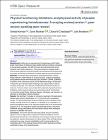| dc.contributor.author | Broderick, Julie | en |
| dc.contributor.author | Mockler, David | en |
| dc.date.accessioned | 2020-05-01T10:26:01Z | |
| dc.date.available | 2020-05-01T10:26:01Z | |
| dc.date.issued | 2020 | en |
| dc.date.submitted | 2020 | en |
| dc.identifier.citation | Sin?ad Kiernan, David Mockler, Cl?ona N? Cheallaigh, Julie Broderick, Physical functioning limitations and physical activity of people experiencing homelessness: A scoping review,, HRB Open Research, 3, 14, 2020 | en |
| dc.identifier.other | Y | en |
| dc.identifier.uri | https://hrbopenresearch.org/articles/3-14/v1 | |
| dc.identifier.uri | http://hdl.handle.net/2262/92412 | |
| dc.description | PUBLISHED | en |
| dc.description.abstract | Background: Adults who are experiencing homelessness suffer higher levels of premature mortality and age-related medical conditions compared to the general population, but little is known about physical factors that influence their health experience. This review aimed to evaluate what is known about physical functional limitations and physical activity levels, and how these constructs are measured in adults experiencing homelessness.
Methods: This review was conducted in accordance with the Joanna Briggs Institute’s methodology for scoping reviews. Suitable quantitative and qualitative articles were searched using PubMed, CINAHL, EMBASE, PsychInfo, Web of Science and SCOPUS databases using a combination of keywords and medical subject headings and a grey literature search was also performed. Two reviewers independently screened articles for inclusion. Inclusion criteria were studies that examined physical functional limitations and/or physical activity among homeless adults (with/without co-occurring mental illness, infectious disease, substance use disorder), as a primary or secondary outcome measure.
Results: We identified 15 studies for inclusion including 2,018 participants. Studies were primarily quantitative (n=11) and there were 4 qualitative studies. The following physical focused measures were evaluated across studies; mobility levels (n=2), frailty (n=1), flexibility (n=2), strength (n=1), physical symptom burden (n=3), physical activity levels (n=6) and exercise capacity (n=3). The majority of studies reported high levels of functional limitations among participants and low physical activity levels although a spectrum of abilities was noted.
Conclusion: This review showed that many adults who are homeless appear to show a high burden of physical functional limitations and low physical activity levels but more objective and consistent measures should be applied to examine these factors in future studies. This will help address and plan future care, physical rehabilitation and housing needs for this vulnerable cohort. This scoping review will help direct research and future systematic reviews in this emerging area. | en |
| dc.language.iso | en | en |
| dc.relation.ispartofseries | HRB Open Research | en |
| dc.relation.ispartofseries | 3 | en |
| dc.relation.ispartofseries | 14 | en |
| dc.rights | Y | en |
| dc.subject | Functional status | en |
| dc.subject | Physical activity | en |
| dc.subject | Homeless adults | en |
| dc.subject | Homelessness | en |
| dc.title | Physical functioning limitations and physical activity of people experiencing homelessness: A scoping review, | en |
| dc.type | Journal Article | en |
| dc.type.supercollection | scholarly_publications | en |
| dc.type.supercollection | refereed_publications | en |
| dc.identifier.peoplefinderurl | http://people.tcd.ie/broderju | en |
| dc.identifier.peoplefinderurl | http://people.tcd.ie/mocklerd | en |
| dc.identifier.rssinternalid | 216127 | en |
| dc.rights.ecaccessrights | openAccess | |
| dc.relation.doi | https://doi.org/10.12688/hrbopenres.13011.1) | en |
| dc.relation.cites | Cites | en |
| dc.subject.TCDTheme | Inclusive Society | en |
| dc.subject.TCDTag | Health inequality | en |
| dc.subject.TCDTag | Health outcomes | en |
| dc.identifier.orcid_id | 0000-0002-2572-6479 | en |
| dc.subject.darat_impairment | Chronic Health Condition | en |
| dc.subject.darat_impairment | Epilepsy | en |
| dc.subject.darat_impairment | Mobility impairment | en |
| dc.subject.darat_impairment | Physical disability | en |
| dc.subject.darat_thematic | Health | en |
| dc.status.accessible | N | en |




